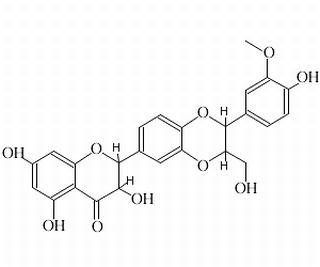Home
Products
Isosilybin



| Product Name | Isosilybin |
| Price: | $204 / 10mg |
| Catalog No.: | CN05193 |
| CAS No.: | 72581-71-6 |
| Molecular Formula: | C25H22O10 |
| Molecular Weight: | 482.44 g/mol |
| Purity: | >=98% |
| Type of Compound: | Flavonoids |
| Physical Desc.: | Powder |
| Source: | The herbs of Silybum marianum (L.) Gaertn. |
| Solvent: | Chloroform, Dichloromethane, Ethyl Acetate, DMSO, Acetone, etc. |
| SMILES: | OCC1Oc2cc(ccc2OC1c1ccc(c(c1)OC)O)C1Oc2cc(O)cc(c2C(=O)[C@@H]1O)O |
| Contact us | |
|---|---|
| First Name: | |
| Last Name: | |
| E-mail: | |
| Question: | |
| Description | Isosilybin (Isosilybinin) is a flavonoid from milk thistle; inhibits CYP3A4 induction with an IC50 of 74 μM. |
| Target | IC50: 74 μM (CYP3A4)[1] |
| In Vitro | The reporter gene assay shows that milk thistle’s components silybin and isosilybin are responsible for the inhibition of PXR-mediated CYP3A4 induction by milk thistle. Compared with silybin, its isomer isosilybin is a stronger inhibitor of PXR-mediated CYP3A4 induction. A solution of 89, 133, and 200 μM isosilybin significantly inhibits CYP3A4 induction by 64, 82, and 88%, respectively. Isosilybin inhibits CYP3A4 induction with an IC50 of 74 μM[1]. Isosilybin B and isosilybin A, two diastereoisomers isolated from silymarin, have anti-prostate cancer (PCA) activity that is mediated via cell cycle arrest and apoptosis induction. Isosilybin B and isosilybin A treatment results in growth inhibition and cell death together with a strong G(1) arrest and apoptosis in human prostate cancer LNCaP and 22Rv1 cells[2]. Isosilybin B causes increased phosphorylation of Akt (Ser-473 and Thr-308) and Mdm2 (Ser-166), which is linked with androgen receptor degradation as pretreatment with PI3K inhibitor (LY294002)-restored androgen receptor level. Isosilybin B treatment enhances the formation of complex between Akt, Mdm2 and AR, which promotes phosphorylation-dependent AR ubiquitination and its degradation by proteasome[3]. Isosilybin A is able to significantly activate PPARγ at a concentration of 30 μM (2.08±0.48 fold, p<0.01). Isosilybin A causes transactivation of a PPARγ-dependent luciferase reporter in a concentration-dependent manner. In silico docking studies suggests a binding mode for 3 distinct from that of the inactive silymarin constituents, with one additional hydrogen bond to Ser342 in the entrance region of the ligand-binding domain of the receptor[4]. |
| Cell Assay | LNCaP cells and 22Rv1 cells are plated and treated at 40–50% confluency with different doses of isosilybin B and isosilybin A (10–90 μM in medium) dissolved originally in Dimethyl sulfoxide (DMSO) for the desired time periods (24–48 h) in serum condition. An equal amount of DMSO (vehicle) is present in each treatment, including control; DMSO concentration did not exceed 0.1% (v/v) in any treatment. At the end of desired treatments, total cell number is determined by counting each sample in duplicate using a hemocytometer under an inverted microscope. Cell viability is determined using trypan blue exclusion method[2]. |
| Density | 1.5±0.1 g/cm3 |
| Boiling Point | 793.0±60.0 °C at 760 mmHg |
| Flash Point | 274.5±26.4 °C |
| Exact Mass | 482.121307 |
| PSA | 155.14000 |
| LogP | 2.59 |
| Vapour Pressure | 0.0±2.9 mmHg at 25°C |